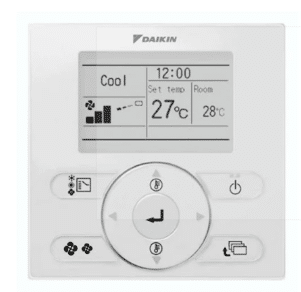
Air conditioner controllers (known as thermostat's in other parts of the world) are a vital part of your home cooling system. Knowing the signs and symptoms of a faulty AC controller can save you time and money, and it's important to diagnose the issue as soon as possible. Common signs of a broken controller include temperature readings that are too high or too low, air not properly coming out of the controller is broken can save you time and money. In this article, we will discuss common signs and symptoms of a faulty AC controller, how to diagnose the problem, and what steps you should take to fix it.
You will either have a wired or wireless controller. Most wall mount splits have a wireless controller, whilst ducted systems almost always have wired controllers. Your wired controller will normally be powered from the mains. Whilst the wireless controller will be battery powered.
The wireless controller has an additional fault point being - being the receiver board on the indoor unit of your air conditioning system.
One of the most common signs that your controller has no power is that it will not turn on or off. If you press the on/off button, but nothing happens, then your controller likely doesn't have any power going to it. This may be caused by either flat batteries or a faulty power supply.
If your AC won't turn on even when the controller is set to the desired temperature, this could be a sign that the controller (including the temperature sensor (the thermistor) within the controller) is faulty and needs to be replaced.
The most common reason why your air conditioner won't turn off even when it turns on with a faulty controller is because there is a faulty thermostat - which doesn't sense when the correct temperature is reached. Obviously this can lead to increased energy bills and the system not achieving the set temperature. This can be caused by a number of things, including: an electrical short circuit, a loose connection, or a damaged internal component.
A faulty controller with a reading different to the room temperature can be caused by a number of factors. It could mean that the resistor in the thermostat is no longer functioning effectively - causing it to report an incorrect temperature. It could also mean that the wiring in your system has become degraded and is no longer properly transmitting signals
A different temperature to actual, especially when higher than the actual temperature, will cause your air conditioner to run longer than it needs to, consuming more electricity than is needed.
A non-responsive AC controller is a sign of a malfunctioning controller because it indicates that the thermostat's internal wiring or components are not functioning properly.
Short cycling is when an air conditioner rapidly turns on and off throughout the day, sometimes within minutes of cycle - - which in turn means your air conditioning system may be going to prematurely wear and be inefficient.. This is a sign of a faulty controller because it means that the controller isn’t accurately regulating the temperature. The thermistor in the thermostat may be malfunctioning and not be sending accurate information to the controller.
When an air conditioner controller forgets its programmed settings, it is a sign of a faulty controller.
Controllers, when functioning correctly, normally resume at the last settings, including temperature setting, when turned off. They often have battery back-up - so they don't forget settings in the event of power disruption to the air conditioner
If you suspect that your air conditioner controller is broken, it’s important to take action quickly. If you feel confident you should first inspect any visible wiring and connections for any signs of damage or loose connections. If all looks good in terms of electrical components, then you may need to replace the control pad / control module in their entirety - as they are not normally maintainable items. It can be difficult to diagnose a faulty AC controller on your own so if in doubt, contact an experienced technician who will be able to accurately determine what needs fixing and provide you with the best solution for getting your home cooling system back up and running again.